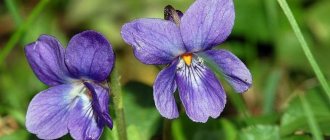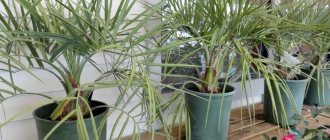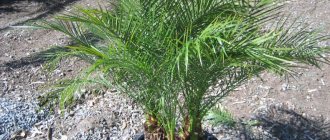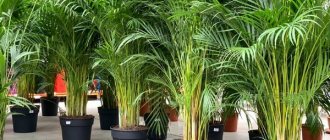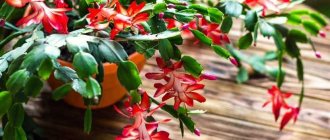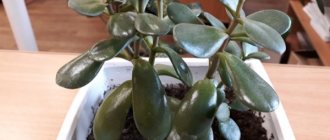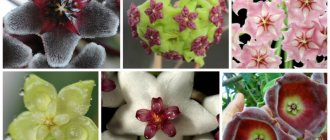What do we know about such amazing tropical plants? Is this a tree or a shrub? Where is their homeland? How to properly care for them? What do indoor flowers in the form of palm trees look like in the photo?
We hope that you will find answers to all these questions in our article.
general description
Palm trees are considered the most ancient plants that originally reproduced by seeds and pollen. Under natural conditions, they can reach up to 9 meters in height if growth is not artificially restrained. The size of a palm tree at home depends on care. The tallest palm tree in the world is the Wax Palm; its height can reach up to 50 meters. This tree is the main plant symbol of Colombia.
The name comes from the Latin word “palma”, which means “palm”. And this is not surprising, because the leaves of the plant really resemble splayed fingers on the palm of a person.
The flowering of an indoor palm tree is similar to the flowering of a calla lily.
For example, yucca has large white flowers that look like bells. Basically, the palm tree blooms with small yellow or white flowers on a small cluster.
I would like to remind you that it was not nature that created indoor plants for us, but we are trying to grow them in the hope that they will take root at home. Palma is no exception. There are several types that will feel great at home:
Appearance of the plant
On average, a palm tree lives about 150-200 years. For example, a coconut tree takes about 100 years to grow and produces about 450 nuts each year.
ON A NOTE! A coconut can travel thousands of kilometers through water, wash ashore, and germinate there.
There are 2 types of palm trees:
- With fan leaves. They diverge radially from the base. A prominent representative is the date palm.
- Cirrus. The leaves spread parallel to the sides from the vein in the center. A prominent representative is the bamboo palm.
Palms are perennial trees, less often shrubs, most of which have a non-branching trunk, at the top of which a crown grows. They can also grow as vines with thin stems. There are up to 1,500 species in tropical and subtropical areas.
Peculiarities
- The trunk of a palm tree usually does not branch (an exception is the genus of doom palms). Its thickness is about a meter, and during life it does not thicken. Among the palm trees there are climbing vines, the stems of which are about 2-3 centimeters thick and up to 300 meters long.
- The inflorescence of a palm tree is a spadix that is of impressive size and branches. Flowers are located on the branches, sometimes they are immersed in its tissue. All inflorescences are surrounded by a veil.
- What fruits grow on a palm tree? They can be in the form of a nut or a bone or a berry. Ornamental palms produce fruits in the form of small round berries.
Exotic varieties
Let's talk about the types of exotic palm trees and how they bloom.
The most common include:
- Brachea. Loves light, but grows best in partial shade. Can't do without spraying. Watering is moderate.
- Boothia. A palm tree whose leaves resemble feathers. Blooms in late spring.
- Washingtonia. Fan palm, pleasing the eye with white blossoms. Can reach a height of up to 18 meters.
- Giophorba. The young representative resembles a vase in appearance. It blooms with small flowers and smells pleasant.
- Hamedorea. It is considered the most unpretentious species and tolerates shade well. Blooms almost all year round.
- Kariota. The leaves of the plant look like a fish tail. It blooms once a year for 5-6 years.
- Liviston. The leaves look like an open fan, reaching a height of up to 2 meters. Ideal for rooms.
- Rapis. It grows as a shrub. Very whimsical.
- Chamerops. Massive palm tree with a dense crown. Blooms from April to June.
- Yucca. A tree-like plant whose leaves are collected in bunches. The white flowers look like bells.
- Govea. An elegant plant reaching a height of up to 2.5 meters. Requires careful care.
- Date palm. The most common species, grows as a lush shrub.
- Sabal. A plant with fan-shaped leaves. The types of palm trees growing in the rooms are absolutely different from each other.
- Trachycarpus. It reaches a height of up to 2.5 meters and grows very slowly. Suitable for apartments.
Required temperature and room features
The palm tree is a representative of tropical fauna, and therefore, in indoor growing conditions, it also requires heat. Optimal conditions for species such as Hamerops, Trachycarpus, Washingtonia will be a temperature of 15 degrees. Absolutely all types of this crop do not like drafts, and the root system is vulnerable to cold, so it is not recommended to place the container with the plant on a cold floor or an unsealed windowsill. The ideal option would be the corner of a warm, well-lit room.
Article on the topic: Puruma cecropiefolia description and features
Where is your homeland?
The tropics and subtropics are considered to be the homeland of the palm tree. These zones are the native habitat of trees. Where do they usually grow? Most often they can be found in Africa and Eurasia, as well as some regions of Central Asia.
The plant has become widespread in many regions of the globe. They are more often found on the shores of tropical seas, high in the mountains and in humid forests. A huge number of species grow in Colombia and Madagascar. The fan palm is more common in Spain. The feathery representative can be seen more often in Greece.
Also, some species grow in the territory of the former Soviet Union, for example, on the southern coast of Crimea.
You can see what a flower in the form of an indoor palm tree looks like in the photo here. Howea Forster
Hamedorea
Rapis
Brachea
Washingtonia
Giophorba
Kariota
Liviston
Hamerops
Yucca
Date palm
Sabal
Trachycarpus
Distinctive features of palm trees
There are about 2,800 species of palm trees around the globe. They differ from most plants in that the leaves grow at the top. However, there are palm trees whose leaves come from the root bud.
Let's take a closer look at all the types with names and photos.
There is the following division of indoor palm trees, based on the characteristics of the leaves and trunk:
Reed . Some Hamedoreas, Rapuses. Their stems are thin, tall, and reed-like.
Cirrus . Hamedorea eleganta, Howea Forster and Belmora, date - Roblen and Canary date, Raffia, Gomuti. These palms have narrow, arched leaves that can be straight and grow upward. The crowns of this group are both soft and hard.
Fans . Chamerops squat and tall, Washingtonia, Rapis tall, Livistonia chinensis. The crowns of such palm trees are split into many segments extending from the center and look like a round fan; they grow very large, their petioles have thorns.
Sagoceae . False, but have the appearance of real palms, only one species is grown for decorative purposes - Cycad avertus, a low plant that has a cone-shaped small trunk from which long feathery leaves radiate.
"Fish tail" . Kariota belongs to this species. The leaves look like a fish's tail - a diamond- or triangular-shaped fin, hence the name, these are one of the fastest growing palms.
Plants that resemble them in appearance are often mistaken for palm trees. For example, dracaenas and yuccas.
What kind of care does it require?
Growing an exotic plant at home is not so easy. It needs proper care:
- It is recommended to place the pot with the plant on the south side of the house.
- In summer, the temperature should range from 16 to 20 degrees Celsius.
- In summer, be sure to moisturize the crown.
- From early spring until late autumn, a palm tree blooming at home needs abundant watering. Drying out the soil is unacceptable.
- Green beauties love light very much, but they cannot be exposed to direct sunlight.
- The plant is afraid of drafts.
- The soil for growing should be light and flat.
- Palm trees need regular feeding and fertilizer.
Soil requirements and replanting
Planting a thin, slender betel palm tree in the wrong soil can result in an unsightly appearance or even death of the plant. The soil must be nutritious, with a neutral or slightly acidic pH. Experienced gardeners recommend mixing the soil for growing a tree with a moderate amount of bone meal, pumice, pine bark, charcoal, and peat.
It is important to create good drainage in the pot where the palm tree grows. For this, expanded clay is used, which is laid in a thick layer on the bottom of the container. It is designed to prevent possible stagnation of water in the root system of the palm tree.
Transplantation is carried out exclusively in the spring and only when the tree becomes cramped in the pot. The earthen lump always remains on the roots, since the plant does not tolerate any manipulation well. And in stores you often come across betel palms, which grow several in one pot. It is not recommended to separate them.
Distribution[edit | edit code ]
The natural distribution area of most palm trees is the tropics and subtropics. Especially many types of palm trees grow in Madagascar and Colombia. In Europe, in Spain and the south of France, the fan palm Chamaerops humilis
), which can withstand frosts down to −12 degrees Celsius, and also in the south of mainland Greece and Crete there are groves of the feathery Cretan date palm (
Phoenix theophrastii
).
Chamaerops grow on the territory of the former USSR in areas with a subtropical climate - on the Black Sea coast of the Caucasus and the southern coast of Crimea, as well as in Azerbaijan and Georgia.
,
Phoenix
,
Sabal
,
Trachycarpus
,
Washingtonia
and some others.
Biological description [edit | edit code ]
The trunk usually does not branch (except for the genus of doom palms), quite often palm trees have the appearance of shrubs, some representatives do not have any stems at all, only leaves rise above the surface of the ground. The thickness reaches 1 meter (yubeya), the height is up to 50-60 m (ceroxylon), while among the palm trees there are climbing vines with stems 2-3 cm thick and up to 300 m long (rattan). The leaves are either pinnate (coconut palm, date palm, foxtail palm, Howea, Hamedorea, etc., in Caryota they are bipinnate) or fan-shaped (Chamerops, Trachycarpus, Liviston palm, etc.).
Flower formula: ∗ C a 3 C o 3 A 3 + 3 G ( 3 ) _ <3>;Co_<3>;A_<3+3>;G_<(3)>>> [4] .
